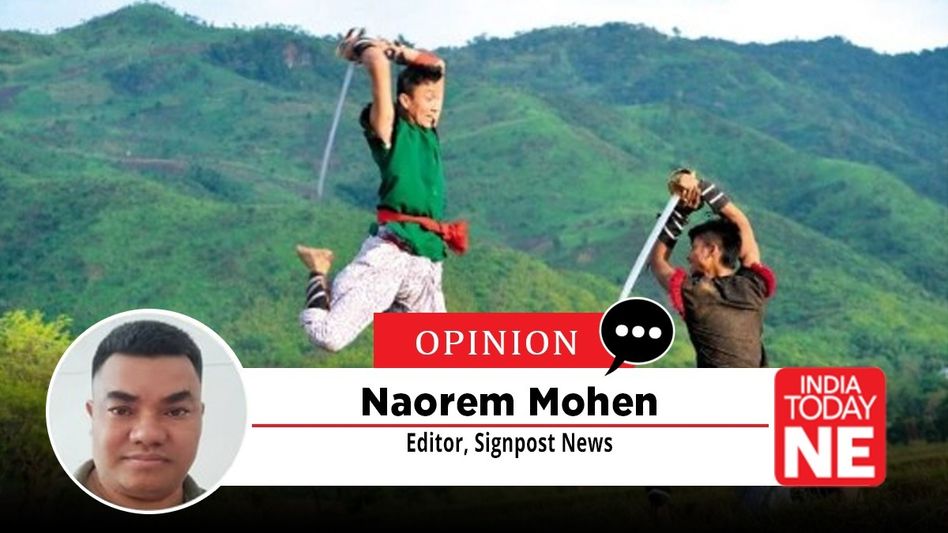Demography May Change, But History of Manipur Does Not
Manipur survived because the Meitei stood in the breach. This is not pride speaking; it is history. No village of a few hundred souls could have held back the Burmese legions, Chinese incursions, or British columns. Had the Meitei shield broken, Manipur would long ago have vanished into someone else’s empire, and every claim today to “ancestral land,” “tribal homeland,” or “separate administration” would have been extinguished forever. The debt is not to a community; it is to the very existence of this land we all call home.

Manipur survived because the Meitei stood in the breach. This is not pride speaking; it is history. No village of a few hundred souls could have held back the Burmese legions, Chinese incursions, or British columns. Had the Meitei shield broken, Manipur would long ago have vanished into someone else’s empire, and every claim today to “ancestral land,” “tribal homeland,” or “separate administration” would have been extinguished forever. The debt is not to a community; it is to the very existence of this land we all call home.
Today some voices speak of bifurcation, trifurcation, or separate administrations. They do so armed with the strength of present-day numbers. But numbers acquired in the last seventy or hundred years do not possess the moral or historical authority to dismember a kingdom that was born united, defended united, and merged united.The valley’s indigenous people, who once formed a clear majority, became a plurality, and then a shrinking one, while carrying the historical burden of defending the entire kingdom.
Manipur is not a province carved out by the British in 1947, nor a state drawn on the map by the States Reorganisation Act of 1956. It is one of Asia’s oldest continuous kingdoms, a sovereign civilisation that flourished for more than two thousand years under an unbroken line of sixty-seven kings of the Ningthouja dynasty, from Pakhangba to Bodhchandra in 1949. It is not a colonial construct or a post-1947 administrative unit. Its boundaries once touched the foothills of the eastern Himalayas, reached deep into the Cachar plains, and embraced the Kabaw Valley—territories recognised in treaties and defended by blood long before the British drew their lines on maps.
To call the Meitei a “dominant community” is to distort history. Call us instead what the records testify: rulers of an independent kingdom and builders of a civilisation that defended its sovereignty for centuries. The land is not a recent creation; it is a kingdom shaped by more than sixty-seven kings who ruled continuously until the merger with India in 1949. The structure of the state, its administration, its defence, and its cultural identity were created by our forefathers. And while we have never denied that all communities of this land are our brothers, history must be spoken with honesty.
The Meiteis were never a mere “dominant community” in the colonial sense of a majority lording over minorities. History records us as the architects, defenders, and custodians of an independent kingdom that built palaces, moats, canals, temples, literature, dance, martial arts, and a script of its own. Meitei were the state-bearing people who gave this land its name, its flag, its army, its diplomacy, and its identity in the comity of nations.
Consider the Tangkhul population: in the 1951 Indian Census, barely thirty-four thousand. Imagine their numbers during 1819, when Manipur was invaded and occupied by the Burmese for seven long years. The Zeliangrong were our brothers too, but historically their population was also very small. During the Anglo-Manipur War of 1891, only a few Naga groups were able to participate—not because they lacked loyalty, but because their numbers were extremely limited.
The major responsibility of defending the kingdom against external aggression, whether from Burma, the British, or others, was carried by the kings of Manipur and the people under the Meitei crown. That is a simple historical fact. Our kingdom once extended up to the China border and deep into Cachar. The Kabaw Valley was well within our territory and was later placed under Burmese control through colonial arrangements, not because our claim was weak.
When this land merged with India in 1949, it did so with boundaries fixed under the 1826 Treaty of Yandabo. The land measured eighteen thousand square miles with a population of 5.12 lakhs. Growing populations today do not rewrite the historical foundations of this land. Demography may change, but history does not. No one can claim today that because a community has grown in numbers over the last century, it suddenly possessed an independent administration, army, or sovereignty in the 18th or 19th century.
At the heart of the kingdom stood the Meitei people—not merely a majority, but the architects of its palaces, canals, forts, chronicles, script, army, treasury, and diplomacy. The state was theirs; the name “Manipur” was theirs; and the burden of its survival rested upon their shoulders. Long before the Burmese dreamt of conquest, it was Manipur that made Ava tremble. In 1723, the kingdoms of Ava and Takhel (Tripura) forged a rare alliance, striking from opposite directions in a massive pincer—Burmese columns from the south-east, Tripuri armies from the south-west—hoping to crush the valley kingdom.
King Pamheiba divided his forces, fought on two distant fronts, and in the same season defeated both enemies, sending shockwaves across South-East Asia. What followed was even more extraordinary. Between 1725 and 1748, Pamheiba carried out relentless expeditions deep into Burmese territory, campaigns preserved in British records drawn from Burmese chronicles and Manipuri court documents.
E.W. Dun’s Gazetteer of Manipur (1886) recounts how in 1725 he routed a Burmese force at the Maglang river; in 1726 he repulsed 30,000 invaders and captured three divisions; in 1735 he crossed the Chindwin, destroyed Myedu, and carried off thousands of captives; and in 1737–38, with 20,000 men, he stormed the stockades around Sagaing and seized the ancient capital itself after devastating armies totalling over 25,000 men, 3,700 horse, and 50 elephants. Yet the tide shifted in the latter half of the 18th century.
G.E. Harvey’s History of Burma (1925) records that in 1765 King Hsinbyushin of Burma sent 50,000–60,000 men into Manipur. At that time, most hill communities within Manipur’s frontiers numbered only a few hundred souls—some clans scarcely more than a handful of families. Still, the Meitei kings and their guerrilla fighters resisted, retreating into the hills when necessary, harassing the occupiers for years, and ultimately driving them out.
The cycle of devastation repeated: in 1780, thousands were taken to the Mogok ruby mines; in 1812, another forty-five families were deported; and in 1819–1826 came the darkest chapter—the Seven Years Devastation (Chahi Taret Khuntakpa), when at least 60,000 Meiteis were marched to Burma in chains within two years, forced into mines and resettlements.
Entire valley were emptied; survivors hid among Tangkhul, Thangal, Maring, Kabui hills or fled to Cachar. When Prince Gambhir Singh returned in 1825 with a few hundred men and British support, he found a valley where deer and elephants grazed among the ruins of once-thriving villages.
The British census of 1881 bears a hard truth: the total population of Manipur stood at 221,070, of whom Meiteis numbered 124,254 (56.2%), Nagas 59,904, Thadou 17,204, smaller tribes (Kom, Aimol, Lamkang, Chothe, Chiru, Anal, etc.) 8,180, and Muslims 4,881. By 2011, according to the Government of Manipur, the Meitei annual growth rate of 7.17 % is the lowest of all major communities. The Meitei share of the population has fallen from 56.2 % in 1881 to 44.91 % in 2011. Demography has shifted — dramatically in some cases — through a combination of natural increase and large-scale in-migration that no serious observer denies. In contrast, Kuki-Zo groups expanded at 13.82%, Muslims at 37.03%, and “Migrants” at 18.47%.
The origins of the Kukis and Zo in Manipur are unambiguously recorded in colonial accounts. Their first arrival occurred during the reign of Maharaja Nar Singh (1844–1850), when groups displaced from the Chin Hills by the Suktes sought refuge in the valley. Carey and Tuck note that in 1876, more than 2,000 Guite migrated from the Chin Hills and were settled near Moirang. Likewise, Colonel E.B. Elly reported that in 1882, some 3,000 Paites, long oppressed by the Lushais, crossed into Manipur territory to establish new settlements.
When the first Indian Census was taken in 1951, barely two years after merger, the surviving Meitei population still stood at 3,39,994. After genocide-scale deportation, mass killings, famine, and exile, more than three lakh Meiteis remained — the living core of a state that had sheltered every community within its historic frontiers. Let this 1951 Census, the first impartial count taken by independent India, speak with brutal clarity.
In the same record, the communities that today most aggressively claim the hills of Manipur as their exclusive “ancestral homeland” and demand separate administration were recorded as follows: Thadou 44,976; Paite 10,672; Hmar 9,793; Vaiphei 4,241; Zou 3,053; Gangte 2,496; Any Mizo (Lushai tribes) 2,662; Simte 2,027; and Ralte 39. Major Kuki-Zo tribes that now number in the lakhs could not even cross the 11,000 mark in 1951; most hovered between one and five thousand; many were below three thousand.
Among Naga groups, the Tangkhul numbered 34,543; Kabui 19,186; Kacha Naga 8,819; Maring 4,987; Anal 3,239; Lamkang 1,688; Chiru 1,079; Chothe 695; Moyon 521; Aimol 335; and Kom 2,490. These are not Meitei figures—they are Government of India statistics taken when the grandparents of today’s generation still carried living memory of the Burmese terror.
No one denies that migration, both internal and cross-border, has been a reality in Manipur, especially since the late 19th century. No one denies that fertility rates differ. But no amount of demographic change in the last century can rewrite the preceding two thousand years.
A community that numbered only a few thousand in 1821 or 1881 simply could not have fielded armies, built forts, paid tribute to Ava one year and fought them the next, or negotiated treaties with the Governor-General in Calcutta. The oft-repeated cry “in defence of ancestral tribal land” carries emotional weight today, but historically it rings hollow when the same census documents show that, at the very moments the kingdom faced annihilation, most of these community populations were tiny clans living safely under the protection of Meitei kings and Meitei soldiers.
The combined population inside Manipur of all the Kuki-Zo tribes listed above was, at most, a few thousand souls—probably closer to a few hundred scattered families living in remote pockets under the shelter of the Meitei crown. Yet today their descendants, having multiplied in the long peace purchased exclusively by Meitei blood and organisation, declare that the hills have “always” belonged solely to them and that the Meitei kingdom which protected, fed, and defended them for two thousand years is now an alien intruder.
These figures are not Meitei inventions; they are official statistics of the Government of India, recorded when the grandparents of today’s generation still carried living memory of the Burmese devastations. The combined population of all Kuki-Zo tribes within Manipur in 1951 amounted to only a few thousand souls—likely closer to scattered families in remote pockets under the shelter of the Meitei crown, some clans no larger than a dozen households.
Yet their descendants, having multiplied in the long peace secured by Meitei blood and Meitei organisation, now proclaim that the hills have “always” belonged solely to them, casting the very kingdom that protected, fed, and defended them for two millennia as an alien intruder. The 1951 Census exposes such claims as historically untenable and logically absurd.
A few thousand souls in 1951—and therefore only a few hundred in 1820—never raised an army, never built a fort, never paid tribute to Ava, never rebuilt a kingdom after genocide. They survived and grew only because the Meitei state stood as their shield.
To demand the dismemberment of that shield on the strength of numbers acquired in the last seven decades is to reward the protection their ancestors received while punishing those who bore the cost. The 1951 Census is a mirror no rhetoric can shatter: it records who carried the kingdom through fire and who, in 1951, remained a tiny protected minority. Everything that has unfolded since is the fruit of Meitei sacrifice.
These are not judgements on the worth of any community; they are simple demographic facts. Who bore the primary burden of defending the kingdom against Burmese, Chinese, Tripuri, Cachari, and British invasions? Who rebuilt the state after each devastation, maintained the Lallup army, fortified Mao and Tengnoupal, and negotiated with Ava and London?
It was the kings of the Meitei crown and the Meitei people who carried that responsibility for centuries, while extending refuge, land, and security to every brother community within the kingdom’s frontiers. Demography has changed—sometimes naturally, sometimes through migration—but demography does not erase history. No community can claim that because its numbers grew in the last century, it suddenly possessed an independent administration, army, or sovereignty in the 18th or 19th century.
The phrase “in defence of ancestral tribal land” rings hollow when the 1951 Census itself shows that most tribal populations in Manipur were minuscule at the very time the kingdom was fighting for survival—and when 60,000 Meiteis were marched off to slavery in a single two-year period. This is not to deny any community’s ancient roots or sacrifices. Nagas, Kukis, and every brother community fought bravely whenever they could. But the disproportionate burden of historical responsibility rested on the Meitei crown, because the state structure, the army, the treasury, and the diplomacy were centred in the kingdom they built and sustained.
When Manipur merged with India on 21 September 1949, it did so as one indivisible kingdom of 22,327 square kilometres with a population of about 5.12 lakh. Those boundaries were drawn by our ancestors’ swords and treaties, not by the Census of 2011 or the politics of 2025.
Growing populations cannot redraw history or fracture what our forefathers kept united through two millennia of turmoil. Today, some communities demand division, armed with the strength of present-day numbers. But numbers acquired in the last century do not confer the moral authority to fracture a kingdom that was born united, defended united, and merged united.
We Meiteis claim no supremacy today—only the honest recognition of yesterday. From Loktak’s quiet waters to Koubru’s peaks, from Tamenglong’s forests to Chandel’s eastern hills, the land was kept whole because Meitei kings and Meitei blood stood guard when many of today’s larger communities were still small clans under the kingdom’s protection. Let us all—valley and hill, Meitei, Naga, Kuki, Pangal—honour that shared history. Let no one sow division in the name of new numbers.
Manipur was born united. It was defended united. It entered India united. Let it remain united—forever.
Copyright©2025 Living Media India Limited. For reprint rights: Syndications Today









